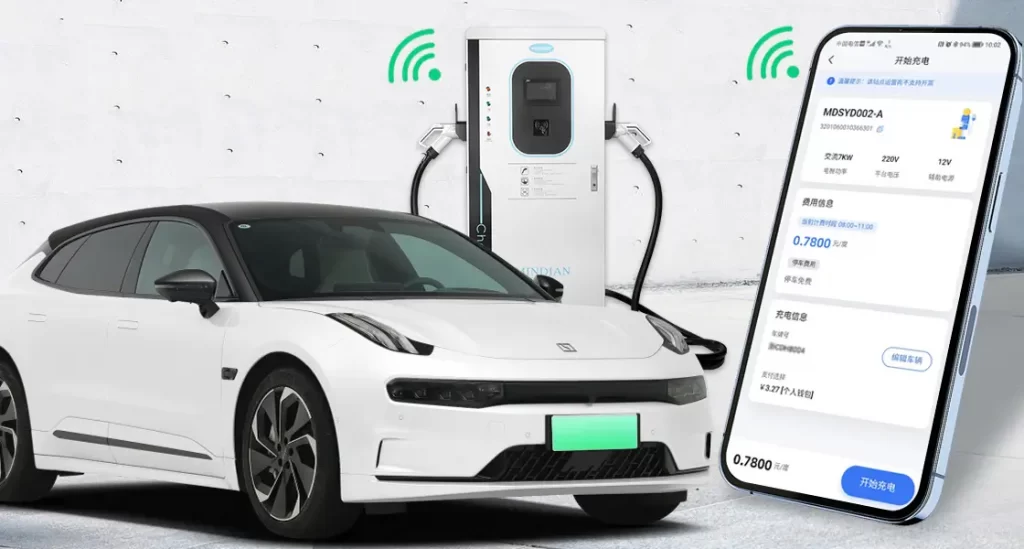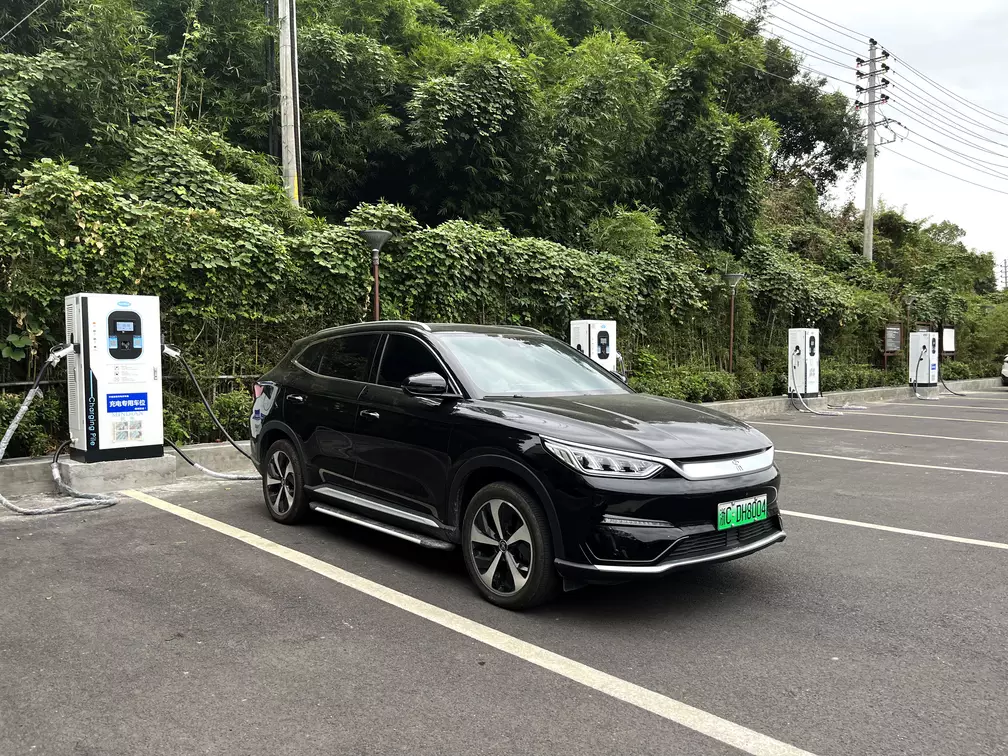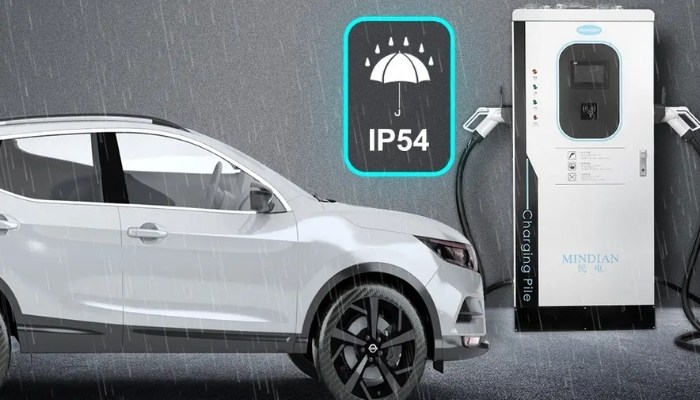DC Fast Charging mainly charges the vehicle battery quickly through high-power direct current. Compared with traditional AC charging (AC Charging), DC fast charging can provide a large amount of power to EVs in a short time, significantly shortening the charging time.
How Many Kilowatts Are DC Fast Chargers?
DC fast chargers usually range in power from 50 kilowatts (kW) to 350 kilowatts (kW):
- 50 kW: Basic fast charging power, suitable for some small EVs and older models, with a slower charging speed.
- 150 kW: Medium-power DC fast charging, which can charge most EVs quickly and can charge to about 80% in 30 minutes.
- 250-350 kW: High-power fast charging, mainly used for high-end EVs, can charge 80% of the power in 15-20 minutes.
The actual power of the charger will automatically adjust according to factors such as the vehicle’s battery capacity, charging protocol, and temperature to ensure safety and battery life.
How DC Fast Charging Works

The battery of an EV stores DC power, while the power grid usually provides AC power. During AC charging, the onboard charger inside the vehicle converts AC power into DC power and then stores it in the battery.
However, the power of the onboard charger is usually limited, resulting in slow charging speed. DC fast charging stations directly convert AC power into DC power and transmit it directly to the vehicle battery at high power, bypassing the limitations of the onboard charger and achieving faster charging speed.
Pros of DC Fast Charging
The advantages of DC Fast Charging can be divided into the following aspects, each of which is as follows:
1. Fast Charging Speed
The biggest feature of DC Fast Charging is that it can charge the battery from 20% to 80% in 30 minutes, and some higher-power charging stations can even complete a similar amount of charging in 10-20 minutes.
Unlike AC charging, DC Fast Charging directly inputs high-power DC to the battery, bypassing the car’s inverter and making charging more efficient.
In such a high-efficiency charging situation, you can learn about this blog: How Often Should I Charge My EV to 100% to better protect your car?
2. More Convenient Long-Distance Travel
DC Fast Charging is very suitable for EV owners who drive long distances. It is usually set up in highway service areas and major travel nodes, which can quickly recharge EVs and reduce charging waiting time.
Many suppliers will invest in the construction of these charging stations along highways and transportation hubs. These stations will allow car owners to stop briefly and continue their journey, significantly improving the convenience of long-distance travel.
3. Adapt to High-Demand Scenarios

DC Fast Charging is very practical in certain usage scenarios, especially for EV fleets that need frequent and efficient charging, such as taxis, online car-hailing, logistics fleets, etc. Since these vehicles have a high working intensity, the time for parking and charging is usually short, and battery power needs to be restored quickly to maintain operation.
Therefore, DC Fast Charging can provide stable and efficient charging services for such vehicles, reducing the time that the vehicle is stopped for charging and improving operational efficiency.
4. Enhance the Market Appeal of EVs
The expansion of the DC Fast Charging network has significantly promoted the popularity of EVs. As more cities, shopping malls, and public areas install fast charging facilities, EVs are more attractive due to the convenience of charging.
The convenient fast charging experience lowers the threshold for traditional fuel vehicle users to switch to EVs, making it a reliable choice for daily commuting and long-distance travel. This advantage not only increases consumers’ willingness to buy but also promotes the overall development of the EV market.
5. Reduce the Pressure on Charging Station Use
Since DC Fast Charging can complete a large amount of charging in a short time, vehicles can leave the charging position more quickly, which to some extent alleviates the congestion problem of charging stations.
Compared with AC slow charging stations, DC fast charging stations can serve more vehicles at the same time, thereby improving the utilization rate of charging facilities. This is a significant advantage for both charging station managers and EV users, as it reduces user waiting time and improves the operating efficiency of charging stations.
6. Efficient Revenue Stream and Quick Return
Since DC Fast Charging can provide high-power charging for vehicles in a short time, each charging station can serve multiple vehicles, greatly improving the unit time revenue of charging stations.
Compared with AC slow charging, DC fast charging stations can quickly rotate users and achieve higher passenger flow during high-demand periods. Therefore, charging station operators who invest in DC Fast Charging can obtain faster cost recovery through higher charging prices and frequent customer use. If you want to buy these fast-charging piles in large quantities, you can contact the manufacturer of MOREDAYDC online. They provide retail and wholesale, and the more you buy, the more discounts you will get!
DC Fast Charging has played a significant role in improving charging efficiency and reducing user waiting time, bringing better user experience to EV users.
Charging Curve of DC Fast Charging
During DC fast charging, the charging rate of the battery is not constant. Generally, the battery is charged at a higher power when the battery is low, and the charging rate gradually decreases as the battery approaches 80% to protect the battery life.
Therefore, it is recommended that users end fast charging when the battery is charged to 80% to improve charging efficiency and extend battery life.
Connection Standards for DC Fast Charging
The main connection standards for DC fast charging in the world include:
- CCS (Combined Charging System): widely used in North America and Europe, with strong compatibility, supporting AC and DC charging, and is the mainstream choice of many brands.
- CHAdeMO: Mainly used in Japan and some Asian countries, supports two-way charging (V2X), allowing EVs to power homes or power grids.
- GB/T: China’s national standard, widely used in domestic charging networks to ensure local EV compatibility.
- Tesla Supercharger: Tesla’s proprietary fast charging standard, with high charging efficiency, and gradually compatible with the CCS standard, improving charging flexibility.
These standards adapt to the needs of different regions and brands and promote the diversification of global charging infrastructure.
FAQ
Can All EVs Use DC Fast Chargers?
Not all EVs can use DC fast chargers, because some models do not have DC fast charging capabilities, and the charging interface standards of different regions and brands are different, such as CCS, CHAdeMO, GB/T, and Tesla Supercharger, and only vehicles with matching interfaces can use it.
Is Fast Charging Bad for EV Batteries?
DC fast charging may have a certain impact on EV batteries when used frequently, mainly manifested in a slight shortening of battery life. This is because high-power charging will increase the battery temperature and accelerate the battery’s chemical reaction, thereby increasing the aging rate of the battery.
However, modern EVs are generally equipped with a battery management system (BMS), which can monitor and adjust the charging power and temperature to reduce the impact of fast charging on the battery.
Related reading: Is Fast Charging Bad for EV Batteries?


